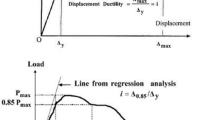Abstract
Strengthening of the structures with external shear walls recently has become an attractive alternative compared to conventional strengthening methods. These external shear walls can be erected either cast-in-place or by pre-casting. However, cast-in-place construction is difficult and time consuming especially in multistory buildings. On the other hand, a single precast panel is too heavy for transportation and assembly. These difficulties might be overcome by producing precast panels as multi-piece panels. However, in that case, behavior of connections between panels will be important as it could control the failure mode of the shear wall. For this reason, this study is aimed at testing the behavior of different types of precast panel connections. Within this study, one monolithic reference model and two precast panel models having anchored connection details were produced. The behavior of connections was tested under reversed-cyclic lateral loads. The results showed that ductility of the models with connections are significantly lower than monolithic specimen. Although, each panel has good RC detailing with proper confinement and concrete quality, connections are the governing elements that control the behavior. Cracking was only observed at the connection, and there were no proper plastic hinge formations at the panels. Therefore, it was concluded that anchored connections cannot be designed for high ductility levels. Some suggestions are made regarding the area of use of anchored connections in precast panels.















Similar content being viewed by others
References
Baran M, Tankut T (2011) Experimental study on seismic strengthening of RC frames by precast concrete panels. ACI Struct J 108(2):227–237
Booth E (1994) Concrete structures in earthquake regions, design and analysis. Longman Scientific and Technical, Harlow Essex
Ersoy U, Özcebe G, Tankut T (2000) Damages observed after 1999 Marmara and Düzce earthquakes at precast structures. In: Proceedings of the 10th prefabrication symposium, vol 1. Istanbul, Turkey, pp 1–10 (in Turkish)
Frosch RJ, Wanzhi L, Jirsa JO, Kreger ME (1996) Retrofit of non-ductile moment-resisting frames using precast infill wall panels. Earthq Spectra 12(4):741–760
Hashim MSAW, Sinan YHS (1991) Prediction of ultimate shear strength of vertical joints in large panel structures. ACI Struct J 88:S25
Hofhein CL, Reaveley LD, Pantelides CP (2002) Behavior of welded plate connections in precast concrete panels under simulated seismic loads. PCI J 47(4):122–133
İnel M, Özmen HB, Bilgin H (2008) Modelling of non-linear behavior of reinforced concrete members. Project No.105M024, The Scientific and Technological Research Council of Turkey (TUBITAK), Ankara, Turkey (in Turkish)
Kaltakçı MY, Öztürk M, Arslan MH (2010) An experimental investigation for external RC shear wall applications. Nat Hazards Earth Syst Sci 10(9):1941–1950
Kaplan H, Yılmaz S (2012) Seismic strengthening of reinforced concrete buildings. In: A. Moustafa (ed) Earthquake-resistant structures—design, assessment and rehabilitation, chap 16, InTech, Croatia
Kaplan H, Nohutcu H, Çetinkaya N, Yılmaz S, Gönen H, Atımtay E (2009) Seismic strengthening of pin-connected precast concrete structures with external shear walls and diaphragms. PCI J 54(1):88–99
Kaplan H, Yılmaz S, Çetinkaya N, Atımtay E (2011) Seismic strengthening of RC structures with exterior shear walls. Indian Acad Sci 36(1):17–34
Mander JB, Priestley MJN, Park R (1988) Theoretical stress-strain model for confined concrete. ASCE J Struct Eng 114:1804–1826
Pantelides CP, Volnyy VA, Gergely J, Reaveley LD (2003) Seismic retrofit of precast concrete panel connections with carbon fiber reinforced polymer composites. PCI J 48(1):92–104
Polat U, Göktepe S, Gürses E (2000) Behavior and seismic rehabilitation of prefabricated frame and panel wall structural systems. In: Proceedings of the 10th symposium on prefabrication, İst., Turkey, pp 117–126
Sachanski S (1978) Earthquake resistance of precast structures. In: Proceedings of the 6th European on earthquake engineering, Dubrovnik, pp 3–28
Soudki KA, Rizkalla SH, LeBlanc B (1995a) Horizontal connections for precast concrete shear walls subjected to cyclic deformations part 1: mild steel connections. PCI J 40(4):78–96
Soudki KA, Rizkalla SH, Diakiw RW (1995b) Horizontal connections for precast concrete shear walls subjected to cyclic deformations part 2: prestressed connections. PCI J 40(5):82–95
Soudki KA, Jeffrey SW, Rizkalla SH, Bruce B (1996) Horizontal connections for precast concrete sheare wall panels under cyclic shear loading. PCI J 41(3):64–80
Turkish Earthquake Code (TEC) (2007) Specifications for buildings to be built in seismic areas. Ministry of Public Works and Settlement, Ankara (in Turkish)
Turkish Standards (TS708) (2010) Steel for the reinforcement of concrete—reinforcing steel, Turkish Standards Institute, ICS 77.140.60, April, 2010, Ankara, Turkey (in Turkish)
Yılmaz S, Tama YS, Kaplan H (2010a) Design and construction of external precast shear walls for seismic retrofit. In: 14th European conference on earthquake engineering, Ohrid, Macedonia, p 1238
Yılmaz S, Çetinkaya N, Nohutcu H, Çalışkan Ö, Çırak İF (2010b) Experimental investigation of anchors in external strengthening shear walls. Project No.107M572, The Scientific and Technological Research Council of Turkey (TUBITAK), Ankara, Turkey (in Turkish)
Yüzügüllü Ö (1979) Strengthening of reinforced concrete frames damaged by earthquake using precast panel elements. Project No.MAG-494, The Scientific and Technological Research Council of Turkey (TUBITAK), Ankara, Turkey (in Turkish)
Acknowledgments
This study was supported by The Scientific and Technological Research Council of Turkey (TUBITAK) under Project No. 110M340. Authors acknowledge Suat Tasdelen and Ibrahim Kayalı for their helps in drawings.
Author information
Authors and Affiliations
Corresponding author
Rights and permissions
About this article
Cite this article
Solak, A., Tama, Y.S., Yılmaz, S. et al. Experimental study on behavior of anchored external shear wall panel connections. Bull Earthquake Eng 13, 3065–3081 (2015). https://doi.org/10.1007/s10518-015-9748-8
Received:
Accepted:
Published:
Issue Date:
DOI: https://doi.org/10.1007/s10518-015-9748-8



